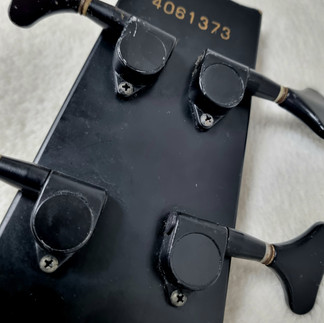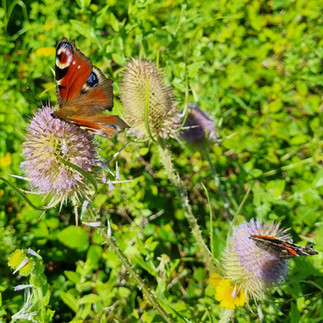AXE TRACKS Episode 3: Westone Thunder Jet & Beholding a Pale Horse ~~VINTAGE GUITAR REVIEW
- Tim Baker
- Aug 14, 2023
- 5 min read
Updated: Aug 15, 2023
We welcome you once more to Axe Tracks: an attempt at loquacity upon landscape and luthiery. This is Episode three, and this time it’s personal.
Thanks for joining me on another vintage guitar review. This time venturing into the wonderful world of Westone, followed by a journey on foot into countryside around Calne, Wiltshire.


The Axe:
1984 Westone Thunder Jet Bass Guitar
To the peaceful suburbs of Calne, where, banished to live out a quiet life of impotent fury, a guttural behemoth slept fitfully in the corner of an attic. Fearing the desolation and havoc it might wreak in an act of revenge on this genteel corner of Wiltshire with its bijou coffee shops and manicured floral displays, I hurtled to the aid of the unsuspecting town. The pulsing throb of a kind of sub-frequency growl spurring me to greater haste.
I mustn’t let poetic licence paint this guitar too abominably. The ‘bete noire’ in question here is the wonderful 1984 Westone Thunder Jet bass guitar. A bass of enormous vintage charm that sets a high watermark for affordable Japanese luthiery and whose maker, Westone continues to have an adoring fan base across the world.

On each occasion I’m lucky enough to take a 1980s Westone guitar into the workshop, I’m taken right back to my twelve year old self, probing the dusty corners of Exchange and Mart, under the dubious eye of Mitch ‘The Stitch’, world-weary proprietor of this cornucopia of records, instruments and assorted pieces of audio flotsam. Clutching an Iron Maiden LP, I’d stare wistfully up at the guitars and over several weeks at one axe in particular. That same 1983 Westone Thunder 1 guitar sits in the rack next to me as I write this and remains one of my most cherished possessions.
The late 1970s saw Japan at the zenith of the guitar making world, applying the same rigorous attention to detail and supreme workmanship that had seen Japan dominate consumer electronics and the automotive world previously. Matsumoku, the factory that produced Westone guitars, along with guitars and parts for famous brands such as Ibanez, Aria Pro II, Epiphone, Yamaha and Washburn, was at the forefront of this burgeoning Japanese economy. It combined state-of-the-art computerised automated manufacture for components with intricate hand worked construction. Indeed 60% of the construction process including planing, fretting and joining was completed by hand with astounding attention to detail, and it is this marriage of high and endearingly low tech that ultimately produced instruments of such calibre and enduring appeal.
The Thunder Jet stolen away from Calne features a solid alder body, coated along with the neck and headstock, in gloss black that has mellowed over the years to a smooth satin. The three-piece maple neck and headstock measures a comfortable 34” scale and the iconic Westone eagle logo at the top, originally outlined in white has eroded with time, leaving a subtle imprint. Each of the 22 frets that sit atop the dark rosewood fretboard are in excellent shape. Providing the sonorous grunt suggested by its name is one single ‘Hard Puncher’ split coil pickup, marshalled by one volume and one tone control. In keeping with the stygian aesthetic, the knobs, bridge and tuners are also jet-black.
Weighing in at 4.2kgs, this bass hangs breezily round the neck and with its tight curves is supremely balanced on the thigh as well as in the air. The neck is shallow allowing for plenty of fret access across the width of the rosewood and the medium frets are proud and true. The ‘Hard Puncher’ pickup lavishes plenty of meat on this woodwork with a thumping mid-range response redolent of any Precision Bass worth its salt. I can’t help thinking Steve Harris would look far better galloping along with this under his arm.
From Calne, something deliciously wicked my way came. And here it sits brooding in the shop, plotting the downfall of an unsuspecting waif. Perhaps another starry eyed metal-mad teenager.

The Tracks:
Walk: NE Calne Circular: 25.42km
County: Wiltshire
Difficulty: Moderate: Total elevation climb: 209m
Time: 4:30 - 5hr

Route: Circular route to the north east of Calne. Anti-clockwise beginning on Low Lane on the eastern edge of Calne, following the 403 National Cycle Route and linking up with the White Horse Trail heading north as far as Highway Common. Then turning southwards through the village of Compton Bassett to rejoin the 403 and Low Lane to complete the loop.

From Low Lane, marked National Cycle Route 403, this route takes in lowland meadows with views west to High Penn Solar Farm before arcing round a high-banked and mysterious works site surrounded by dense vegetation and interspersed by several lakes replete with an impressive variety of dragon & damsel fly and waterfowl.
Just beyond the apex of this arc, the 403 meets the road to Compton Bassett. Stay to the right of the hedge line to continue along a verdant avenue with the steep bank of the works site to your right. Half a kilometre along, join the road and continue for a further five hundred metres, with views over a gentle hillside on the other side of the road. Perched on an upper bough of a dead tree along this road, a buzzard monitored me as I walked almost directly beneath.
At a right angle, take the footpath to the left between magnificent towering grey poplar trees, at this time threatened with unlawful destruction by a property developer. An issue I’m currently taking up with the developers and the council. This secluded footpath runs gently uphill through a dense patch of mature woodland called Baker’s Enclosure and emerges onto a road that runs along the crest of the hill, offering snatched glimpses through the trees, of Cherhill in the valley to the south.
Veer away from the road to the left, opposite farm buildings and head through another patch of woodland called Triangle Wood, the surrounding foliage quickly thinning to open fields as Cherhill Down emerges spectacularly to the right. Today its white horse showing a muted cream in the sepia glow of the late summer sun.
After a kilometre, the footpath joins the White Horse Trail on an ancient bridleway called Juggler’s Lane, meeting the imposing husk of Yatesbury RAF Base, abandoned in 1965 and left to the destructive powers of nature and entropy. I hopped the electric fence and slid through an opening in the security fence to creep around the dilapidated ruin. Invading tendrils of Ivy splayed through the smashed windows. Patches of roof caved-in forcing raw daylight into the dank recesses.
It’s thrilling to experience an abandoned building such as this. The giddy thrill of trespass meets the intimate sadness of human neglect. Coincidentally, the science fiction writer Arthur C. Clarke was stationed here at the start of the second world war and I was stirred by the image of Clarke hunched over a typewriter in the corner of one of these rooms bringing to life tales of Martian invasion or the threat of nuclear apocalypse. The otherworldly vibe of this place was also used to amusing effect by the KLF in their video for Doctorin’ the Tardis in 1988 in which an American cop car pursues a darlek over the weed-strewn concrete of the runway.
Back on the path, the WHT shoots at a right angle northwards just before the airbase and continues for two miles at first along a broad avenue fringed by trees and narrowing to a nettle clad track before abruptly shooting left at a crossroads just north of the hamlet of Highway Penning. Through trees, a gentle slope towards the neighbouring hamlet of Highway opens up with bucolic views of the rolling fields towards Hilmarton.
It’s at this point that my GPS map became impish, directing me towards footpaths across fields that had either long since overgrown or never actually existed. Intending to head South West across the countryside in the direction of Calne, I instead opted to follow the lanes back south. Highway Common, to Withy Bed and the main road through the picturesque village of Compton Bassett. Beyond the village, I followed the westerly curve of the road to rejoin the 403 Cycle route and retrace my steps back up Low Lane to Calne.
Thanks to my walking buddy Sean Kaye-Smith for some additional info in this post.































’There’s No ‘R’ In Dalek’ should be the title of the next Roar at the Meteor album (because there isn’t).